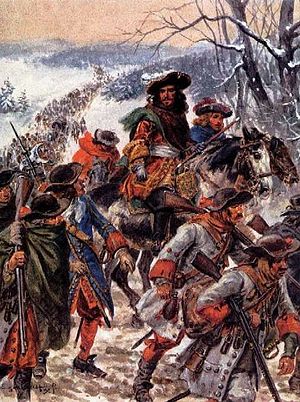Battle of Türkheim
| date | January 5, 1675 |
|---|---|
| place | Turckheim |
| output | French victory |
| Parties to the conflict | |
|---|---|
| Commander | |
|
Alexander de Bournonville |
|
| Troop strength | |
| 30,000 | 30,000 |
| losses | |
|
900 men killed or wounded, 2500 captured (on January 6th in Colmar) |
1,100 men killed or wounded |
Dutch War (1672–1678 / 79)
Solebay - First Schooneveld - Second Schooneveld - Texel - Bonn - Maastricht - Sinsheim - Seneffe - Enzheim - Türkheim - Sasbach - Konzer Bridge - Stromboli - Augusta - Palermo - Kokersberg - Philippsburg - Maastricht - Valenciennes - Tobago - Cassel - Freiburg - Ypres- Rheinfelden - Saint-Denis
The battle of Türkheim (sometimes also called the meeting at Türkheim ) took place at Türkheim (today Turckheim ) in Alsace on January 5, 1675 during the Dutch War . A French army under Turenne and a combined imperial, Lorraine and Brandenburg army under the imperial commander-in-chief Bournonville , the Duke of Lorraine Charles IV and the Brandenburg Elector Friedrich Wilhelm of Brandenburg were involved . The actually insignificant battle turned out to be an important strategic victory for the French due to the subsequent retreat of the Allies from Alsace.
prehistory
In contrast to the French commanders in other theaters of war, Turenne was very active in 1674, although he initially had relatively few troops (about 20,000 men). During this time he systematically devastated the Electoral Palatinate . He successfully prevented the Duke of Lorraine from hindering the occupation of the Free County of Burgundy . This and the imperial general Capara were defeated at Sinsheim on June 16, 1674. Turenne held Alsace against the Allies, even though the French government wanted to give up the area. As a result, he attracted the opposing forces.
Turenne attacked the Imperial on October 4th near Enzheim . Turenne received considerable reinforcements. Conde sent 20 battalions and 80 squadrons. He feigned retreat to winter quarters, but marched south and surprised the allies. He defeated the cavalry of the Imperial, Lorraine and the Duchy of Munster near Mulhouse. But he could not prevent the imperial and Brandenburg troops from uniting at Colmar.
course
Both sides met at Türkheim. Both armies were about equally strong with about 33,000 men. The position of the allies was covered by the fencing canal and some entrenchments. The left wing reached as far as Colmar. The right wing extends almost to Türkheim. The Allies were covered by entrenchments, were posted in two lines one behind the other and, moreover, still had reserves.
The weakest point was the right wing. There Turenne saw the opportunity to bypass the opponents. In view of the march on this side, the allies cleared the previously occupied town of Türkheim on the orders of General Bournonville. This fell to the French. The Duke of Lorraine advanced to a counter-attack and a violent infantry battle broke out. Although the French suffered considerable losses, they were able to hold their own. Two French generals - Faucault and Mouchy - lost their lives in battle. Turenne himself was also in danger when his horse was killed. However, Turenne succeeded in having some of the enemy troops withdrawn from the battlefield by means of a deception. The left wing of the French gained more and more weight against the enemy and they could even be fired at from the side with artillery. The battle was called off with no real clear decision when it got dark.
consequences
While still on the battlefield, the allies decided to retreat across the Rhine. With that, Alsace was left to the French. In this respect, Türkheim was a strategic success for the French. The French stayed overnight on the battlefield and shortly afterwards the Elector of Brandenburg had to leave the theater of war because the Swedes had invaded his territory.
Individual evidence
- ↑ Numbers follow here: Gaston Bodart (Ed.): Military-historical War Lexicon. (1618-1905). Stern, Vienna 1908, p. 96 .
literature
- Adam Heinrich Dietrich von Bülow : Military biographies of famous heroes of recent times. Volume 1: Condé, Tuerenne. Himburgische Buchhandlung, Berlin 1803, p. 323 ff., ( Digitized ).
- Hanns Eggert Willibald von der Lühe (Hrsg.): Militair Conversations-Lexikon. Volume 8: T, U, V, W, X, Y and Z. Verlags-Bureau, Adorf 1841, pp. 348-349, ( digitized version ).
- Gustav von Kortzfleisch : The Upper Alsatian winter campaign 1674/75 and the meeting at Türkheim (= contributions to regional and folk studies of Alsace-Lorraine and the adjacent areas. H. 29, ZDB -ID 212038-0 ). Heitz, Strasbourg, 1904, ( digitized ).
- Francis Smith: The wars from antiquity to the present (= manual for army and navy. Vol. 9 = special volume). Bong & Co., Berlin et al. 1912, p. 378, ( digitized version ).
- Gerhard Taddey (ed.): Lexicon of German history . People, events, institutions. From the turn of the times to the end of the 2nd World War. 2nd, revised edition. Kröner, Stuttgart 1983, ISBN 3-520-80002-0 , p. 1252.
- Cathal J. Nolan: Wars of the Age of Louis XIV, 1650-1715. An Encyclopedia of global Warfare and Civilization. Greenwood Press, Westport CT et al. 2008, ISBN 978-0-313-33046-9 , p. 480.
